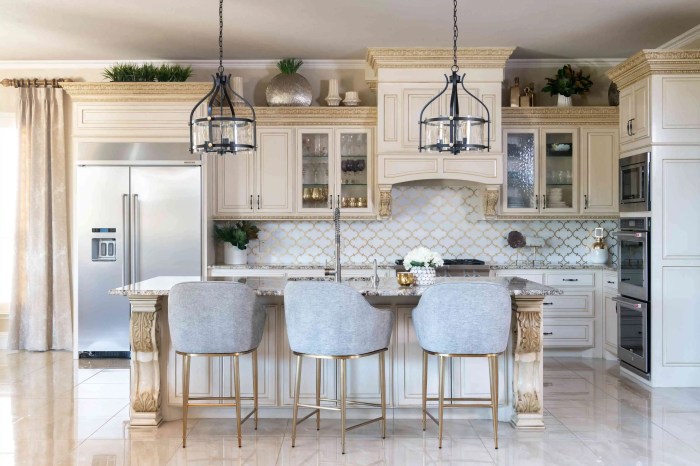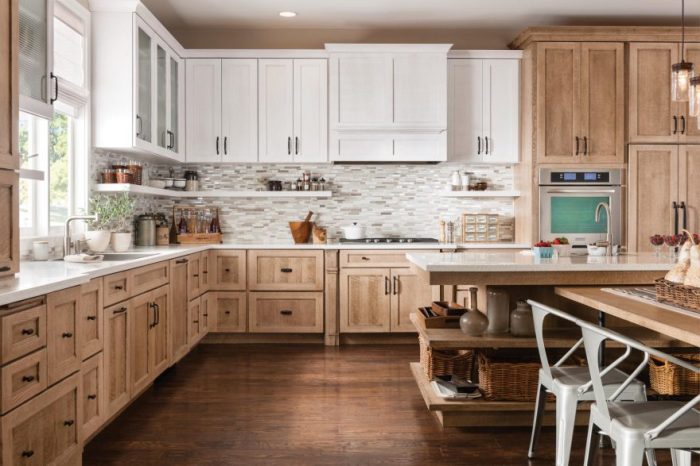Trending Decor Styles Above Kitchen Cabinets (2021): Decor Above Kitchen Cabinets 2021

Decor above kitchen cabinets 2021 – The space above kitchen cabinets presents a unique opportunity to enhance a kitchen’s aesthetic appeal and overall design. In 2021, several decor styles gained popularity, reflecting evolving trends in interior design. These styles offered diverse approaches to utilizing this often-overlooked area, catering to various tastes and design philosophies.
Popular Decor Styles Above Kitchen Cabinets in 2021
Three prominent styles emerged in 2021 for decorating above kitchen cabinets: minimalist, maximalist, and eclectic. Minimalist designs prioritized clean lines and a sparse arrangement, often featuring a single statement piece or a carefully curated collection of items. Maximalist styles, conversely, embraced a more abundant approach, layering textures, colors, and objects to create a visually rich and dynamic display. Eclectic styles combined elements from various design periods and aesthetics, resulting in a unique and personalized look.
Each style offered a distinct visual impact and reflected differing design philosophies.
Okay, so 2021 kitchen cabinet decor was all about that maximalist vibe, right? But don’t forget about maximizing your whole kitchen’s style! Check out some seriously cute ideas for your kitchen window ledge decor, like adding some plants or quirky collectibles – you can find tons of inspo at kitchen window ledge decor. Then, bring that same energy back up to those cabinets with coordinating pieces! It’s all about that cohesive look, babe.
Color Palette Comparisons: Minimalist vs. Maximalist Styles, Decor above kitchen cabinets 2021
Minimalist styles for above-kitchen-cabinet decor typically employed a restrained color palette. Neutral tones such as white, beige, gray, or muted pastels were favored, creating a sense of calm and spaciousness. These colors served as a backdrop, allowing any featured items to stand out. In contrast, maximalist styles utilized a bolder and more diverse range of colors. Vibrant hues, contrasting shades, and even metallic accents were incorporated to create a lively and energetic atmosphere.
The choice between a restrained or vibrant palette directly impacted the overall mood and visual impact of the space. For example, a minimalist approach might feature a single, monochromatic arrangement of white ceramic vases, while a maximalist approach might display a collection of colorful pottery in various shapes and sizes.
Mood Board Examples: Three Distinct Styles
The following descriptions detail three distinct mood boards representing minimalist, maximalist, and eclectic styles for above-kitchen-cabinet decor.
Minimalist Mood Board
This mood board features a predominantly white backdrop. A single, large, textured ceramic vase in a soft beige tone is the focal point. The vase’s matte finish provides a subtle textural contrast against the smooth, white surfaces of the cabinets. A few small, carefully selected succulents in simple white pots are placed alongside the vase, adding a touch of greenery without overwhelming the minimalist aesthetic.
The overall feeling is one of serenity and understated elegance. The materials are limited to ceramic, wood (for the succulents’ pots), and natural plant life.
Maximalist Mood Board
This mood board showcases a vibrant and layered arrangement. The backdrop features a patterned wallpaper with a rich, jewel-toned design. Various objects are layered on shelves, including colorful glassware, antique books, and small decorative boxes in contrasting colors and textures. Metallic accents, such as gold-framed mirrors or brass candle holders, add shine and depth. The textures range from the smooth glass to the rough texture of the books and the metallic sheen of the accents.
The colors are rich and varied, creating a dynamic and energetic display.
Eclectic Mood Board
This mood board combines elements from various styles and periods. A vintage wooden tray serves as the base, displaying a collection of mismatched items: a small antique clock, a hand-painted ceramic plate, a collection of vintage postcards, and a small potted herb plant. The colors are varied but harmonious, with a muted palette punctuated by pops of brighter color from the ceramic plate and postcards.
The textures are diverse, ranging from the smooth surface of the ceramic to the rough texture of the wood and the paper of the postcards. The overall feeling is one of curated individuality and personality.
Practical Considerations and Functionality

Decorating above kitchen cabinets requires careful consideration of both aesthetics and practicality. Factors such as lighting, accessibility, and ease of cleaning significantly impact the overall success and longevity of the design. Ignoring these aspects can lead to a visually appealing but ultimately impractical and frustrating outcome.
Lighting Considerations for Above-Cabinet Decor
Effective lighting is crucial for highlighting decorative elements above kitchen cabinets and integrating them seamlessly into the overall kitchen design. Poor lighting can render even the most exquisite decor underwhelming or even invisible. Recessed lighting, strategically placed above the cabinets, provides even illumination, preventing harsh shadows and showcasing textures and colors. Under-cabinet lighting, while primarily functional for the countertop, can also indirectly illuminate decorative items, creating a warm and inviting ambiance.
Alternatively, decorative pendant lights hung at an appropriate height can serve a dual purpose, providing both ambient lighting and a stylish focal point. For example, a row of small, sleek spotlights focused on a collection of ceramic plates would highlight their intricate details.
Addressing Challenges of Decorating Tall Cabinets
Decorating above tall cabinets presents unique access challenges. Reaching high shelves to dust, clean, or rearrange items can be difficult and potentially dangerous. Employing tools such as step stools or extendable cleaning brushes is essential. Consider using lightweight decorative items to minimize the risk of injury during cleaning or rearranging. Opting for decor that can be easily accessed and cleaned from a distance, such as framed artwork or wall sconces, reduces the need for frequent climbing.
Furthermore, strategically planning the decor placement to allow for easier access from a safe position, like placing items closer to the edges of the cabinets, improves practicality.
Choosing Easy-to-Clean Decorative Items
Selecting visually appealing decor that is also easy to clean is paramount for maintaining a clean and organized kitchen. Materials like glass and metal are generally easier to clean than fabrics or porous materials. Dusting regularly with a soft cloth or microfiber cloth is essential for maintaining the cleanliness of all decorative items. The following table summarizes appropriate cleaning methods for various materials commonly used in kitchen decor:
| Material | Cleaning Method |
|---|---|
| Wood | Dusting with a soft cloth; wiping with a slightly damp cloth (avoid excessive moisture); occasional polishing with wood polish. |
| Metal | Wiping with a mild soap and water solution; drying thoroughly to prevent water spots; using a specialized metal cleaner for stubborn stains. |
| Glass | Wiping with a glass cleaner and a lint-free cloth; avoiding abrasive cleaners. |
| Ceramic | Washing with warm, soapy water; hand-washing delicate items; avoiding abrasive cleaners or scouring pads. |
| Acrylic | Wiping with a damp cloth and mild soap; avoiding harsh chemicals. |
Visual Impact and Overall Design
The visual impact of decor above kitchen cabinets significantly influences the overall aesthetic and perceived spaciousness of the kitchen. Careful consideration of texture, material, color, and the relationship between the above-cabinet decor and the existing kitchen design is crucial for achieving a harmonious and visually appealing space.The interplay of textures and materials creates visual interest and depth. Different textures can add layers of complexity and visual richness.
For example, the smooth surface of a glass display shelf contrasts with the rough texture of a woven basket, creating a dynamic visual effect. Similarly, the use of metallic accents, such as brass or copper, against a backdrop of matte-finished cabinetry can add a touch of elegance and sophistication. The choice of materials also impacts the overall style; natural materials like wood evoke a rustic or farmhouse feel, while sleek, modern materials like acrylic or polished metal contribute to a contemporary aesthetic.
Effects of Color and Light Perception
Color significantly impacts the perception of space and light within a kitchen. Light colors, such as whites, creams, and pastels, tend to reflect light, making the space feel larger and brighter. Darker colors, conversely, absorb light, creating a more intimate and cozy atmosphere. However, overuse of dark colors can make a kitchen feel smaller and cramped. The strategic use of color can also be used to highlight specific features.
For instance, a vibrant accent color above the cabinets can draw the eye upwards and create a focal point, adding visual interest to an otherwise plain wall. A common example is using a bold color like teal or navy blue above white cabinets to create a visually striking contrast.
Decorative Complementarity and Contrast
The decor above kitchen cabinets should either complement or contrast with the overall kitchen design, depending on the desired aesthetic. A complementary approach involves using similar colors, materials, and styles to create a cohesive and unified look. For example, if the kitchen features rustic wooden cabinets, incorporating wooden shelves or decorative items above the cabinets would maintain a consistent style.
In contrast, a contrasting approach involves using different colors, materials, or styles to create a visually interesting juxtaposition. For instance, a modern kitchen with sleek, minimalist cabinets could be complemented by adding vibrant artwork or eclectic decorative items above the cabinets, introducing a sense of playful contrast. The key is to ensure that the contrast is intentional and contributes to the overall design aesthetic, rather than appearing disjointed or clashing.
For instance, a farmhouse kitchen with warm wood tones could contrast beautifully with the addition of sleek, metallic accents above the cabinets. This adds a touch of modern sophistication without compromising the overall rustic charm.
Questions Often Asked
What are some budget-friendly options for decorating above kitchen cabinets?
Repurposed items like vintage books, antique tins, or even collections of pottery can add character without breaking the bank. Consider using thrifted or DIY projects to create unique and personalized décor.
How do I prevent dust accumulation on my above-cabinet décor?
Regular dusting with a microfiber cloth is key. Consider using protective glass or acrylic boxes to shield more delicate items.
What if I have very high cabinets? How can I reach the top?
Utilize a step stool or ladder for safe access. Consider lightweight décor to minimize the effort involved in cleaning and rearranging.
How do I choose décor that complements my existing kitchen style?
Maintain consistency in color palettes and materials. If your kitchen is modern, opt for sleek and minimalist décor. For a rustic look, incorporate natural elements like wood and wicker.

